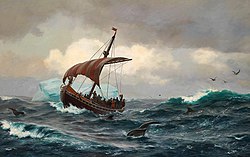

The Vinland Sagas are two Icelandic texts written independently of each other in the early 13th century—The Saga of the Greenlanders (Grænlendinga Saga) and The Saga of Erik the Red (Eiríks Saga Rauða). The sagas were written down between 1220 and 1280 and describe events occurring around 970–1030.[1]
The Saga of Erik the Red and The Saga of the Greenlanders both contain different accounts of Norse voyages to Vinland. The name Vinland, meaning "Wineland," is attributed to the discovery of grapevines upon the arrival of Leif Eiriksson in North America. The Vinland Sagas represent the most complete information available regarding the Norse exploration of the Americas, although due to Iceland's oral tradition, they cannot be deemed completely historically accurate and include contradictory details. However, historians commonly believe these sources contain substantial evidence of Viking exploration of North America through the descriptions of topography, natural resources, and native culture. In comparing the events of both books, a realistic timeline can be created.[2][3]
The veracity of the Sagas was supported by the discovery and excavation of a Viking Age settlement in Newfoundland, Canada. Research done in the early 1960s by Norwegian explorer Helge Ingstad and his wife, archaeologist Anne Stine Ingstad, identified this settlement located at what is now the L'Anse aux Meadows National Historic Site of Canada.[4]
- ^ "Vikings: The North Atlantic Saga". Smithsonian Institution. Archived from the original on February 23, 2002. Retrieved October 18, 2015.
- ^ "Vinland Sagas". Smithsonian Institution National Museum of Natural History. Archived from the original on December 23, 2015. Retrieved October 18, 2015.
- ^ Thayer Watkins. "The Vinland Sagas". San José State University. Economics Department. Retrieved October 18, 2015.
- ^ "L'Anse aux Meadows National Historic Site of Canada". Parks Canada. Retrieved October 18, 2015.